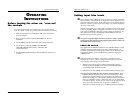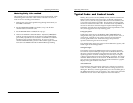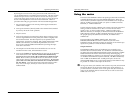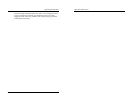
Operating Instructions
Multimix 12R Reference Manual 31
By having the correct level at every point in the send/return chain,
you avoid distortion by overloading and avoid noise. The most common
mistake with effect units is to have too low a level at the send or input, then
crank up the output of the processor or the Aux return to get the effects level
desired. This amplifies the noise and wastes headroom. Here is a
procedure that will give good results with most standard equipment:
1. Set your mixer's input levels correctly, following the instructions
earlier in this chapter.
2. Turn up the channels' [AUX 2] sends to the nominal level (marked
by a heavy dot at the “2:00” position).
3. Play the source.
4. Turn up the input level control of the effect device until you see its
meter or signal LED turn red on peaks; then reduce it slightly until
the red doesn't flash. The ideal input level, for optimum noise
performance, is just below clipping. But if other instruments will be
added to the mix later, or levels are unpredictable (as in a live
show), leave yourself additional headroom by turning the input
level down a bit more.
5. The output level of the effect device should be set at or near its
maximum in most cases, unless distortion occurs.
6. Turn up the [STEREO AUX RETURN] level until you get the desired
level of effect in the mix. The one control in the chain that may
need to be set to a low level is the Aux Return (or channel) on the
mixer. Here is where you should increase or decrease the overall
effect level in the mix, for best low-noise performance. If you want
"just a hint" of reverb, don't turn down the Aux 2 send; turn down
the Aux Return. Leave the input levels of the effect device where
they were set in step 4, unless you see the device's overload
indicator flash.
Operating Instructions
Using the meter
The meter of the Multimix 12R is a fast peak type that reads in decibels,
normally displaying the level of the [MAIN OUT] jacks. When the
meter reads "0", the main outputs are at the nominal level: the phono
jacks at -10 dBV (.316 volts) and the 1/4" jacks at +4 dBu (1.24 volts)
balanced, or -2 dBu unbalanced.
Use this reference level to calibrate your system. The input controls of
analog recorders should be set so that “0” on the mixer's meters
equals “0 VU” on the recorder's meters. Digital recorders use a
different reference; for example, an ADAT connected to the Multimix
12R's outputs will read "-15 dB" at nominal output, if you connect to
the proper input jacks (balanced to balanced, or unbalanced to
unbalanced).
The meter follows the [MSTR/TAPE] switch, but not the
PHONES/MONITOR level control. Whatever you hear in the
headphone output, the master output (up position) or the 2-track tape
input (down position) is what the meter is reading.
Output distortion
The Multimix 12R has plenty of headroom, but eventually every
electronic device reaches its limit. At +18 dB over nominal level, the
top LED of the meter labeled PK will light; at this point there is 6 dB of
headroom before the master electronics will clip. Final clipping is
reached at 24 dB over nominal "0" on the meter; this represents a level
of +28 dBu at the MAIN OUT jacks if balanced, +22 dBu if unbalanced,
and +14 dBV at the MAIN OUT -10 dBV phono jacks. Even if no
channel PEAK LEDs are on, with extreme settings of the faders it may
be possible to overdrive the output to this level.
✪ As long as the meter of the Multimix 12R is below its top LED, and the PEAK
LEDs of all channels are off, the mixer should not be causing distortion. If
you hear distortion, check other devices in the signal chain for overload, and
make sure the STEREO channels' PEAK LEDs do not come on when their
TRIM is set to 12 o'clock.


















